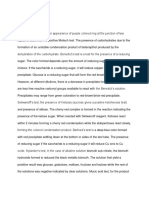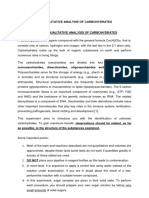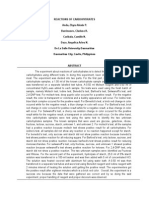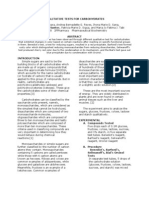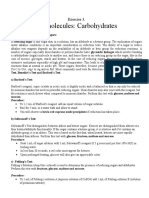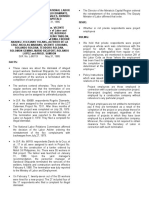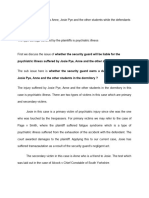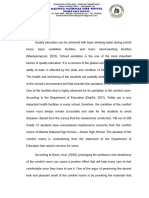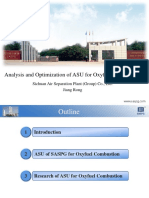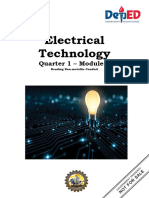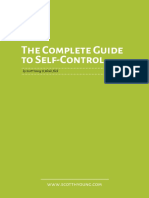Bio
Bio
Uploaded by
Alyssum MarieCopyright:
Available Formats
Bio
Bio
Uploaded by
Alyssum MarieOriginal Title
Copyright
Available Formats
Share this document
Did you find this document useful?
Is this content inappropriate?
Copyright:
Available Formats
Bio
Bio
Uploaded by
Alyssum MarieCopyright:
Available Formats
VI.
Conclusion
There are different chemical qualitative tests conducted namely the Solubility test, Molisch’s test,
Fehling’s test, Benedict’s test, Tollen’s test, Seliwanoff test, Iodine test, Barfoed’s test, Bial’s Orcinol
test and Osazone test to identify different type of carbohydrates. According to the Solubility test
conducted to glucose, lactose, sucrose and starch in water. We found out that glucose, lactose and
sucrose are all soluble while starch resulted in a suspension. To test if a reagent is a non-carbohydrate
(no reaction) or a carbohydrate (purple product) we used the Molisch’s test and through the experiment
we found out that glucose, lactose, sucrose and starch are all carbohydrates. Fehling’s test was
conducted to test if the carbohydrates glucose, lactose, sucrose and starch are non-reducing (no
reaction) or reducing sugars (red product). Glucose and lactose turned red means they are reducing
sugars while sucrose and starch are non-reducing sugars. Seliwanoff’s test was conducted to test if the
carbohydrates glucose, fructose, sucrose, maltose, and starch are aldose/s or ketose/s. And the results
show that fructose and sucrose are ketoses while glucose, maltose and starch are aldoses. Aldoses may
also react but in a much slower rate. Benedict’s test was conducted to test if the carbohydrates glucose,
lactose, sucrose and starch are non-reducing (no reaction) or reducing sugars (red product). Glucose and
lactose are reducing sugars while sucrose and starch are non-reducing sugars. Iodine test was conducted
to test if the carbohydrates have the presence of starch. Among glucose, lactose, sucrose and starch,
only starch exhibited a reaction (dark –blue product). Barfoed’s test was conducted to test if the
carbohydrates glucose, sucrose, fructose, maltose, starch unknown carbohydrate A, unknown
carbohydrate B, unknown carbohydrate C, unknown carbohydrate D and unknown carbohydrate E are
reducing monosaccharide/s (reddish precipitate) or reducing disaccharide/s (no reaction). Glucose,
fructose and unknown carbohydrate C are monosaccharides. Sucrose, maltose, starch, unknown
carbohydrate A, unknown carbohydrate B, unknown carbohydrate D and unknown carbohydrate E are
disaccharides. Disaccharides may also react but in a much slower rate. Bial’s Orcinol test was conducted
to know if the carbohydrates arabinose, fructose and glucose are pentose/s (blue or green product) or
hexose/s (muddy brown-gray product). The results show that all reagents are pentoses. Lastly, Osazone
test was conducted to test the solution (in this lab, the crystalline structure) of a reducing sugar
(glucose) when heated with phenyl hydrazine to form yellow crystalline compounds called Osazone.
Glucose with phenylhydrazine gives glucosephenylhydrazone by eliminating water molecule from the
functional group.
You might also like
- MODULE-11 Practical Research PDFDocument123 pagesMODULE-11 Practical Research PDFAlyssum Marie91% (11)
- Las. SG Carbohydrates 2 1DVM A4 Group2Document7 pagesLas. SG Carbohydrates 2 1DVM A4 Group2Merlyn Limbaga CastroverdeNo ratings yet
- Results and Discussion For CarbohydratesDocument4 pagesResults and Discussion For CarbohydratesDusky25% (4)
- Experiment 1: CarbohydratesDocument6 pagesExperiment 1: CarbohydratesEM Alberts100% (3)
- Exp 5 and 6 Lab Report PDFDocument10 pagesExp 5 and 6 Lab Report PDFIsabel Joice EnriquezNo ratings yet
- PH-PHR 212 Dispensing 1 Course Outline and Syllabus FS 2020-2021Document6 pagesPH-PHR 212 Dispensing 1 Course Outline and Syllabus FS 2020-2021Ira Morante100% (2)
- Characterization of CarbohydratesDocument3 pagesCharacterization of CarbohydratesHyvieNo ratings yet
- Chem Anal5Document6 pagesChem Anal5Christian Rey Hallera BalmoriNo ratings yet
- Exp 6 BioDocument2 pagesExp 6 BioIrdina SufiNo ratings yet
- Experiment 6Document3 pagesExperiment 6Yurii NakadaiNo ratings yet
- Laboratory Activity No. 2 - Analysis of Carbohdrates - 1Document5 pagesLaboratory Activity No. 2 - Analysis of Carbohdrates - 1Juliane JaynNo ratings yet
- Genbio (Tests)Document5 pagesGenbio (Tests)Alecz zzNo ratings yet
- Discussion of ResultsDocument3 pagesDiscussion of ResultsMonica ClauorNo ratings yet
- Experiment No. 3: CarbohydratesDocument6 pagesExperiment No. 3: CarbohydratesAna LuisaNo ratings yet
- Laboratory Activity No. 2 - Analysis of Carbohydrates - 1Document4 pagesLaboratory Activity No. 2 - Analysis of Carbohydrates - 1Juliane JaynNo ratings yet
- Experiment No. 3 CARBOHYDRATESDocument4 pagesExperiment No. 3 CARBOHYDRATESMissy Arabella PameNo ratings yet
- Bio462 Exp 6Document4 pagesBio462 Exp 6Irdina SufiNo ratings yet
- Formal Report - CarbohydratesDocument4 pagesFormal Report - Carbohydratesfefebelmonte100% (2)
- Lab Report For MonossacharideDocument15 pagesLab Report For MonossacharideSay Cheez100% (1)
- Experiment-6A-6B-Answer-Guide (1) CARBOHYDRATESDocument4 pagesExperiment-6A-6B-Answer-Guide (1) CARBOHYDRATESLleana TanNo ratings yet
- Experiment No 1Document6 pagesExperiment No 1John TacordaNo ratings yet
- Expt. 5 BIOCHEMLABDocument9 pagesExpt. 5 BIOCHEMLABEloisah Vin Santiago Ragodon100% (1)
- Isolation and Characterization of CarbohydratesDocument31 pagesIsolation and Characterization of CarbohydratesBenhur Leithold Lapitan50% (8)
- Qualitative Analysis of Carbohydrates ExperimentDocument12 pagesQualitative Analysis of Carbohydrates Experimentasdf65365254750% (2)
- Saccharides and Fehlings Solution, Ionide Test ReportDocument4 pagesSaccharides and Fehlings Solution, Ionide Test ReportJulia ClementNo ratings yet
- Exp. 5 - Reactions of CarbohydratesDocument6 pagesExp. 5 - Reactions of CarbohydratesZhyra Alexis AndaNo ratings yet
- Carbohydrates Practical ReportDocument9 pagesCarbohydrates Practical ReportshubaNo ratings yet
- De Leon, Juliana Rose M. - (CON 1B-BIOCHEMICAL TEST-12:03:21)Document8 pagesDe Leon, Juliana Rose M. - (CON 1B-BIOCHEMICAL TEST-12:03:21)Juliana Rose de LeonNo ratings yet
- FR Qualitative Tests For Carbohydrates 1Document4 pagesFR Qualitative Tests For Carbohydrates 1suzette_santos_20% (1)
- General and Specific Tests For CarbohydratesDocument11 pagesGeneral and Specific Tests For CarbohydratesBrian Rubiano0% (1)
- Biochem ExperimentsDocument9 pagesBiochem ExperimentsAaliyah SantillanNo ratings yet
- Carbohydrates Cell MolecDocument7 pagesCarbohydrates Cell Molecoink100% (1)
- Biochem LabDocument8 pagesBiochem LabMa Anna Cris LumongsudNo ratings yet
- Biochemistry Experiment1 CarbohydratesDocument10 pagesBiochemistry Experiment1 CarbohydratesChery-an PletNo ratings yet
- Carbohydrates TestsDocument4 pagesCarbohydrates TestsTk MakotoseNo ratings yet
- The Molisch TestDocument12 pagesThe Molisch Testkamaksi100% (1)
- Identification of The Unknown CarbohydrateDocument6 pagesIdentification of The Unknown CarbohydrateAngelica DangcoNo ratings yet
- Discussion Part 3Document6 pagesDiscussion Part 3limNo ratings yet
- A Carbohydrate Is An Organic Compound With The General Formula CMDocument6 pagesA Carbohydrate Is An Organic Compound With The General Formula CMHans Louie TabasonNo ratings yet
- Identification of Sugars From Natural SourcesDocument6 pagesIdentification of Sugars From Natural SourcesShoomyla RashidNo ratings yet
- General and Specific Test of CarbohydratesDocument7 pagesGeneral and Specific Test of CarbohydratesAudrey DiolataNo ratings yet
- 3 Test For CarbohydratesDocument8 pages3 Test For CarbohydratesAllyssa Lorraine PrudencioNo ratings yet
- Qualitative Analysis For Carbohydrates Using Glucose, Sucrose, Liver, Paper Pulp and Starch SamplesDocument9 pagesQualitative Analysis For Carbohydrates Using Glucose, Sucrose, Liver, Paper Pulp and Starch SamplesKorrine Gumabon BalaisNo ratings yet
- 11 CarbohydratesDocument6 pages11 CarbohydratesJother AmutanNo ratings yet
- LAS 1-5 Answer KeysDocument12 pagesLAS 1-5 Answer KeysAlthea Joy Sincero BiocoNo ratings yet
- Carbohydrate Analysis - Qualitative Analysis - ENGLISH VERSIONDocument40 pagesCarbohydrate Analysis - Qualitative Analysis - ENGLISH VERSIONAnggii DestianiiNo ratings yet
- BCM Exp 6Document4 pagesBCM Exp 6Fadzal RidzqanNo ratings yet
- Carbohydrates PDFDocument56 pagesCarbohydrates PDFJustine Salvo EvaristoNo ratings yet
- Carbohydrates: Chem 31A-Biochem LabDocument14 pagesCarbohydrates: Chem 31A-Biochem LabMunachande KanondoNo ratings yet
- Laboratory Outline - Exercise 3Document12 pagesLaboratory Outline - Exercise 3Majestic RavenNo ratings yet
- CarbohydratesDocument3 pagesCarbohydratesRuchie Ann Pono BaraquilNo ratings yet
- Biochem Lab 2Document2 pagesBiochem Lab 2Binoy SerinoNo ratings yet
- Practical 1Document6 pagesPractical 1DOUMBOUYA SIDIKINo ratings yet
- VI. Analysis: CHEM 153 Lab Report (Experiment 5)Document3 pagesVI. Analysis: CHEM 153 Lab Report (Experiment 5)Maria Angela OlinanNo ratings yet
- Act 13-15Document14 pagesAct 13-15ferdinand padillaNo ratings yet
- Lab Report 5Document9 pagesLab Report 5Krizia Corrine St. PeterNo ratings yet
- General and Specific Tests For CarbohydratesDocument14 pagesGeneral and Specific Tests For CarbohydratesarellanokristelleNo ratings yet
- BIOL 1362 Lab 1Document18 pagesBIOL 1362 Lab 1Oluchi BairdNo ratings yet
- Experiment 6: Qualitative Tests For Sugars and Amino AcidsDocument4 pagesExperiment 6: Qualitative Tests For Sugars and Amino AcidsAnkush RoyNo ratings yet
- Table 1: Test For Carbohydrates Table 2: Test For Proteins Table 3: Test For LipidsDocument3 pagesTable 1: Test For Carbohydrates Table 2: Test For Proteins Table 3: Test For LipidssamanthakaurNo ratings yet
- Plant and Animal Bio-Chemistry - Including Information on Amino Acids, Proteins, Pigments and Other Chemical Constituents of Organic MatterFrom EverandPlant and Animal Bio-Chemistry - Including Information on Amino Acids, Proteins, Pigments and Other Chemical Constituents of Organic MatterNo ratings yet
- AQA Biology Unit 1: Revision Notes: myrevisionnotes, #1From EverandAQA Biology Unit 1: Revision Notes: myrevisionnotes, #1Rating: 5 out of 5 stars5/5 (2)
- BSN 1-A Group No. 4 Experiment 4Document11 pagesBSN 1-A Group No. 4 Experiment 4Alyssum Marie100% (2)
- Activity 1 and 2 Allyssa Marie Gascon GA 2ADocument5 pagesActivity 1 and 2 Allyssa Marie Gascon GA 2AAlyssum MarieNo ratings yet
- Activity 1 T Accounts Allyssa Marie Gascon GA 2ADocument2 pagesActivity 1 T Accounts Allyssa Marie Gascon GA 2AAlyssum MarieNo ratings yet
- RSEARCH 12 2nd Sem-ADocument29 pagesRSEARCH 12 2nd Sem-AAlyssum MarieNo ratings yet
- ALLYSSA MARIE GASCON - Application For Learning To Be A Better Student - Plan of ActionDocument1 pageALLYSSA MARIE GASCON - Application For Learning To Be A Better Student - Plan of ActionAlyssum MarieNo ratings yet
- Human Hair and Coconut Coir As Hybrid Membrane For LeadDocument62 pagesHuman Hair and Coconut Coir As Hybrid Membrane For LeadAlyssum MarieNo ratings yet
- Siomais Group One Gascon Hindiana Monong Moquera Sarinas Parpa TadeoDocument25 pagesSiomais Group One Gascon Hindiana Monong Moquera Sarinas Parpa TadeoAlyssum MarieNo ratings yet
- Letter From MomDocument14 pagesLetter From MomAlyssum Marie100% (2)
- Muscular System Anatomy and Physiology - NurseslabsDocument32 pagesMuscular System Anatomy and Physiology - NurseslabsAlyssum MarieNo ratings yet
- Background of The Study (PROJECT PROPOSAL) - 11Document2 pagesBackground of The Study (PROJECT PROPOSAL) - 11Alyssum MarieNo ratings yet
- Endocrine System Anatomy and Physiology - NurseslabsDocument29 pagesEndocrine System Anatomy and Physiology - NurseslabsAlyssum Marie50% (2)
- Law of ReflectionDocument3 pagesLaw of ReflectionAlyssum Marie100% (2)
- Lymphatic System Anatomy and Physiology - NurseslabsDocument35 pagesLymphatic System Anatomy and Physiology - NurseslabsAlyssum MarieNo ratings yet
- CULTURE - Cells, Tissues, Organs, or Organisms Grown For Scientific Purposes, or The Activity of BreedingDocument1 pageCULTURE - Cells, Tissues, Organs, or Organisms Grown For Scientific Purposes, or The Activity of BreedingAlyssum MarieNo ratings yet
- Understanding The Self - Part 1 and Part 2 - Gascon, Allyssa Marie BSN 1-ADocument3 pagesUnderstanding The Self - Part 1 and Part 2 - Gascon, Allyssa Marie BSN 1-AAlyssum MarieNo ratings yet
- Daily PlanDocument1 pageDaily PlanAlyssum MarieNo ratings yet
- Lab Exercises 15, 16, 17 Gascon, Allyssa Marie BSN1ADocument11 pagesLab Exercises 15, 16, 17 Gascon, Allyssa Marie BSN1AAlyssum MarieNo ratings yet
- LAB 18, 19, 20 - Gascon, Allyssa Marie BSN 1-ADocument9 pagesLAB 18, 19, 20 - Gascon, Allyssa Marie BSN 1-AAlyssum MarieNo ratings yet
- Virtual Lab Experiment No. 1 Water and Its PropertiesDocument5 pagesVirtual Lab Experiment No. 1 Water and Its PropertiesAlyssum Marie100% (1)
- RA 9163 - Allyssa Marie Gascon BSN 1-ADocument2 pagesRA 9163 - Allyssa Marie Gascon BSN 1-AAlyssum MarieNo ratings yet
- Exercise-234 A & PDocument1 pageExercise-234 A & PAlyssum MarieNo ratings yet
- My Philosophy About Self - Allyssa Marie L. Gascon BSN 1-ADocument1 pageMy Philosophy About Self - Allyssa Marie L. Gascon BSN 1-AAlyssum MarieNo ratings yet
- Introduction To TFN - Gascon Allyssa Marie L. BSN 1-ADocument3 pagesIntroduction To TFN - Gascon Allyssa Marie L. BSN 1-AAlyssum MarieNo ratings yet
- Explain SocratesDocument3 pagesExplain SocratesAlyssum MarieNo ratings yet
- Jelyn LDocument1 pageJelyn LAlyssum MarieNo ratings yet
- GOOD Example Assignment 1Document2 pagesGOOD Example Assignment 1Nor SyalwanisNo ratings yet
- HACODocument162 pagesHACOKomatsu Perkins HitachiNo ratings yet
- Labrel CasesDocument5 pagesLabrel CasesJoy Orena0% (1)
- Separation and Analysis of Some Sugars by Using Thin Layer ChromatographyDocument2 pagesSeparation and Analysis of Some Sugars by Using Thin Layer ChromatographyTapasNo ratings yet
- Annexure-1 - Micro Action Plan Fro Anganwadi Children ScreeningDocument5 pagesAnnexure-1 - Micro Action Plan Fro Anganwadi Children ScreeningZEETECH COMPUTERSNo ratings yet
- CMR SedationDocument2 pagesCMR SedationYong Wai100% (1)
- Single Period Model - Full Marginal Cost Analysis Approach: Number PurchasedDocument18 pagesSingle Period Model - Full Marginal Cost Analysis Approach: Number PurchasedHernan Pumasupa SolanoNo ratings yet
- The Boy Next Door CYOADocument18 pagesThe Boy Next Door CYOAwatertankk100% (2)
- The Perceived Effect of Broken Family On The Academic Performance of Junior High School Students at San Luis National High SchoolDocument6 pagesThe Perceived Effect of Broken Family On The Academic Performance of Junior High School Students at San Luis National High SchoolGladysNo ratings yet
- Kajian Investasi Bisnis Hotel Budget Di Medan: Lokasi Bandara KualanamuDocument10 pagesKajian Investasi Bisnis Hotel Budget Di Medan: Lokasi Bandara KualanamufitrifirdaNo ratings yet
- s5 179019321 3 PDFDocument4 pagess5 179019321 3 PDFEmily MertesNo ratings yet
- (LIA1006) Ans ScriptDocument7 pages(LIA1006) Ans ScriptA.r.RajendranNo ratings yet
- Hernia CMEDocument28 pagesHernia CMEsantokh108No ratings yet
- Maglev Trains - How Maglev Trains Work - by Alex Landovskis & Veronique RondeaDocument3 pagesMaglev Trains - How Maglev Trains Work - by Alex Landovskis & Veronique RondeaarnavraizadakhushiNo ratings yet
- Diesel Generator Set: (A Wholly Owned Subsidiary of Compass Group PLC)Document38 pagesDiesel Generator Set: (A Wholly Owned Subsidiary of Compass Group PLC)sayedmhNo ratings yet
- PR2 IntroductionDocument3 pagesPR2 IntroductionRem Beatriz DelgadoNo ratings yet
- Staffing of A Nursing Educational InstituteDocument26 pagesStaffing of A Nursing Educational InstituteBaishali DebNo ratings yet
- Dice Resume CV Tapan Patel PDFDocument2 pagesDice Resume CV Tapan Patel PDFlaxmiNo ratings yet
- Midterm-Exam-Test-Paper ALONDRADocument6 pagesMidterm-Exam-Test-Paper ALONDRAMae CherryNo ratings yet
- Psychosocial and Environmental Stressor ChecklistDocument6 pagesPsychosocial and Environmental Stressor ChecklistAnonymous GdBua151uNo ratings yet
- Know ThyselfDocument156 pagesKnow Thyselflpballerini2010No ratings yet
- Sichuan Air SeparationDocument25 pagesSichuan Air SeparationFarshad Asgari0% (1)
- Temi 9 1727299Document4 pagesTemi 9 1727299Dennys Samillan OrtizNo ratings yet
- Soal Ekonomi Mikro A Dan BDocument5 pagesSoal Ekonomi Mikro A Dan BRetno IswandariNo ratings yet
- Jonathan K Lab ReportDocument3 pagesJonathan K Lab Reportjonathanko990630No ratings yet
- Pharmaceutical Dosage Form Lab Prep 6-18Document7 pagesPharmaceutical Dosage Form Lab Prep 6-18Jana EncaboNo ratings yet
- KellyData-VT-pesticide-MSDS-62719-62719-77-62719-77 Lentrek 6 WT Specialty Herbicide (Dow AgroSciences LLC) 11-16-2004!3!26 49 PMDocument6 pagesKellyData-VT-pesticide-MSDS-62719-62719-77-62719-77 Lentrek 6 WT Specialty Herbicide (Dow AgroSciences LLC) 11-16-2004!3!26 49 PMChristine LopezNo ratings yet
- Week 5 Bending Non-Metallic ConduitDocument18 pagesWeek 5 Bending Non-Metallic Conduitruth eliezer alcazarNo ratings yet
- Guide To Self ControlDocument110 pagesGuide To Self ControlGia Manolea100% (4)












